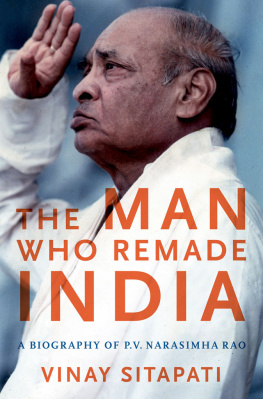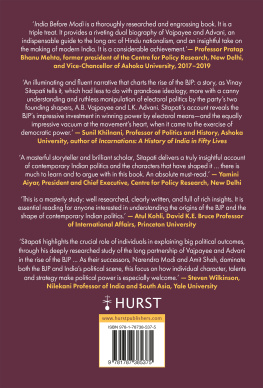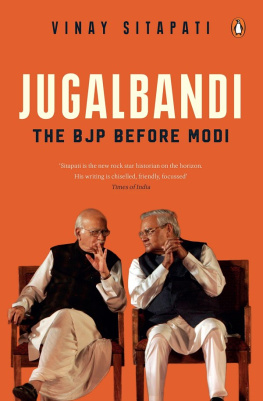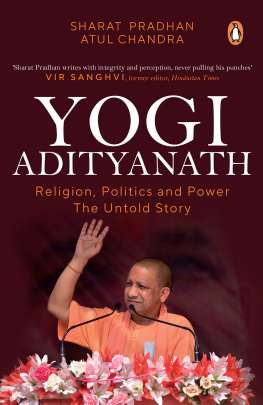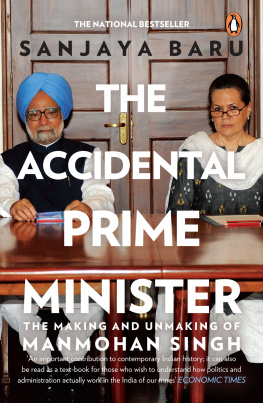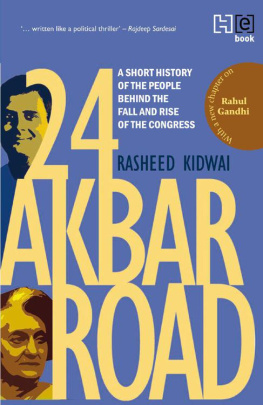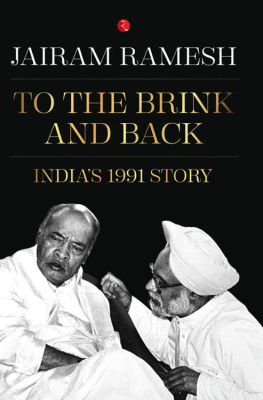THE MAN WHO REMADE INDIA
MODERN SOUTH ASIA
Ashutosh Varshney, Series Editor
Pradeep Chhibber, Associate Series Editor
Editorial Board
Kaushik Basu (Cornell University)
Steven Cohen (Brookings Institution)
Veena Das (Johns Hopkins University)
Patrick Heller (Brown University)
Niraja Gopal Jayal (Jawaharlal Nehru University)
Ravi Kanbur (Cornell University)
Atul Kohli (Princeton University)
Pratap Bhanu Mehta (Centre for Policy Research)
Farzana Shaikh (Chatham House)
The Other One Percent
Sanjoy Chakravorty, Devesh Kapur, and Nirvikar Singh
Social Justice through Inclusion
Francesca R. Jensenius
THE MAN WHO REMADE INDIA
A BIOGRAPHY OF
P. V. NARASIMHA RAO
VINAY SITAPATI


Published in the United States of America by Oxford University Press 198 Madison Avenue, New York, NY 10016, United States of America
Oxford University Press 2018
Published first in India by Penguin India
All rights reserved. No part of this publication may be reproduced, stored in a retrieval system, or transmitted, in any form or by any means, without the prior permission in writing of Oxford University Press, or as expressly permitted by law, by license, or under terms agreed with the appropriate reproduction rights organization. Inquiries concerning reproduction outside the scope of the above should be sent to the Rights Department, Oxford University Press, at the address above.
You must not circulate this work in any other form and you must impose this same condition on any acquirer
Library of Congress Cataloging-in-Publication Data
Names: Sitapati, Vinay, author.
Title: The Man Who Remade India : a biography of P.V. Narasimha Rao / Vinay Sitapati.
Description: New York : Oxford University Press, 2018. | Series: Modern south asia | Includes bibliographical references and index.
Identifiers: LCCN 2017030117 | ISBN 9780190692858 (hardback) | ISBN 9780190692872 (epub) | ISBN 9780190692865 (updf) Subjects: LCSH: Narasimha Rao, P. V., 19212004. | Prime ministersIndiaBiography. | IndiaPolitics and government1977 | BISAC: HISTORY / Asia / India & South Asia. | BIOGRAPHY & AUTOBIOGRAPHY / Political.
Classification: LCC DS481.N312 S58 2018 | DDC 954.05/2092 [B]dc23 LC record available at https://lccn.loc.gov/2017030117
A prince... must imitate the fox and the lion. For the lion cannot protect himself from traps, and the fox cannot defend himself from wolves. One must therefore be a fox to recognise traps, and a lion to frighten wolves.
Niccol Machiavelli, The Prince, circa 1513 AD
The demon king Hiranyakashipu performs penance to achieve immortality. He is granted a boon that he will die neither on earth nor in space, neither in the day nor night, neither at home nor outsideneither by a human nor animal. Confident of cheating death by this clever device, the demon starts believing he is God and unleashes terror. His devout son Prahlada continues to worship Lord Vishnu as all-pervasive. Enraged, Hiranyakashipu points to a pillar and mockingly asks if Vishnu is present within. He shatters the pillar with his mace. Out of the shards emerges Narasimha, an incarnation of Vishnu. Narasimhahalf-man, half-lionkills Hiranyakashipu. The time is twilight, the place is the courtyard, and Hiranyakashipu is killed on Narasimhas lap, neither earth nor space. The ambiguities and contradictions of Narasimha, half-lion, are precisely why he is able to slay the demon.
Story from Narasimha Avatar, Bhagvata Purana, 900 AD
Contents
T he corpse was clad in white dhoti and golden silk kurta. At 2.30 p.m., it was brought from Delhis All India Institute of Medical Sciences to 9 Motilal Nehru Marg. P.V. Narasimha Rao, prime minister of India from 1991 to 1996, had died at around 11 a.m., 23 December 2004. The doctors had needed a couple of hours to dress the body before sending it back home.
One of the first people to arrive at Raos house was Chandraswami, the bearded guru who had known him since 1971. Also present were his eight sons and daughterswhom he had kept at a distanceas well as the nephews and grandchildren he had been closer to. Eldest son, Ranga Raowho had fought bitterly with his fatherwas inconsolable.
Then began the politics.
The home minister, Shivraj Patil, suggested to Raos youngest son, Prabhakara, that the body should be cremated in Hyderabad. But the family preferred Delhi. After all, Rao had last been chief minister of Andhra Pradesh more than thirty years ago, and had since worked as Congress general secretary, Union minister, and finally prime ministerall in Delhi. On hearing this, the usually decorous Shivraj Patil snapped, No one will come.
Kashmiri Congressman Ghulam Nabi Azad, another aide of party president Sonia Gandhi, arrived. He too requested the family to move the body to Hyderabad. An hour later, Prabhakara received a call on his mobile phone. It was Y.S. Rajasekhara Reddy, the Congress chief minister of Andhra Pradesh and no friend of Narasimha Raos. I just heard about it, Reddy said, I am near Anantapur, and Ill be in Delhi by this evening. Take it from me. We will give him a grand funeral [in Hyderabad].
At 6.30 p.m., Sonia Gandhi entered the house in Motilal Nehru Marg, named after her great-grandfather-in-law. Prime minister Manmohan Singh followed, along with Pranab Mukherjee. They walked through the long corridor to the room at the end where Raos body, now decked in flowers, was displayed. What do you want to do with the body? the prime minister asked Prabhakara. These people say it should be in Hyderabad. This [Delhi] is his karmabhoomi, Prabhakara replied, you should convince your Cabinet colleagues. Manmohan nodded. Sonia Gandhi was standing nearby. She said little.
The journalist Sanjaya Baru arrived. His bureaucrat father knew Rao from the 1960s. As Baru entered the corridor, Sonias political secretary tapped him on the shoulder. You know the family, Ahmed Patel said. The body should be taken to Hyderabad. Can you convince them? Baru continued walking towards the end of the corridor, when he heard someone cry. He turned left to see Kalyani Shankar sobbing in a side room. Kalyani had been Raos most trusted friend for the last two decades.
Y.S. Rajasekhara Reddy had by now reached Delhi. It is our government, trust me, he told Raos family. Let him be moved to Hyderabad. We will build a grand memorial for him there. Raos daughter S. Vani Devi says, YSR was playing a major role in convincing [the] family to get the dead body to Hyderabad.
The family wanted a commitment that a memorial would be built for Rao in Delhi. The Congress leaders present said yes. But considering how the party had treated Rao in his retirement, the family wanted to make doubly sure. At 9.30 p.m., they paid a visit to the one man who had stood by Narasimha Rao in the last years of his life. Manmohan Singh was wearing his nightdress, a white kurta-pyjama, when Raos family met him at his official residence on Race Course Road. When Shivraj Patil explained the demand for a memorial in Delhi, Manmohan replied, No problem, we will do it.
Prabhakara recalls, We sensed even then that Sonia-ji did not want Fathers funeral in Delhi. She did not want a memorial [in Delhi]... She did not want him [to be seen] as an all-India leader... [But] there was pressure.

